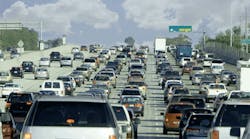The National Safety Council (NSC) has reported a 36.6% year-over-year rise in road fatality rates despite state lockdowns and other precautions to prevent the spread of COVID-19.
Data gathered from all 50 states shows that for the second consecutive month, roads became more deadly even though the number of miles Americans drove dropped 40% compared to April 2019.
Lorraine Martin, NSC president and CEO, commented on the preliminary estimates, saying, "even without traffic, our roads were no safer. It is heartbreaking to see the carnage on our roadways continue, especially when our medical professionals should be able to focus intently on treating a pandemic rather than preventable car crashes. These numbers underscore our urgent need to change the culture of safety on our roads.”
According to the organization's analysis, the mileage death rate per 100 million vehicle miles driven was 1.47 in April compared to 1.08 in 2019. This comes in spite of an 18% drop in the total number of roadway deaths compared to April 2019.
The mileage death rate per 100 million vehicle miles driven in March totaled 1.22, up from 1.07 in March 2019. The NSC noted an 8% drop in the overall number of roadway deaths compared to March 2019.
The organization previously pointed to "anecdotal reports" of drivers speeding and weaving through traffic. It also condemned measures such as those in Georgia that allowed teen drivers to acquire licenses prior to passing road tests. Hours of service rules for commercial vehicle drivers also have been relaxed during the COVID-19 pandemic.
As the first quarter of 2020 (January-April) came to a close, at least eight states have had notable increases in roadway fatalities: Arkansas (24%), Connecticut (45%), Illinois (6%), Louisiana (17%), Minnesota (6%), Nevada (7%), North Carolina (7%) and Oklahoma (6%).
The organization further noted states with decreases in their fatalities rates, including: Arizona (-12%), Colorado (-5%), Hawaii (-34%), Idaho (-36%), Indiana (-16%), Iowa (-16%), Maryland (-14%), Michigan (-17%), New Jersey (-9%), Oregon (-28%), South Carolina (-12%) and Washington (-16%).
The announcement comes just before the Independence Day holiday period which begins at 6 p.m. ET Thursday, July 2. Alcohol is expected to be a major factor in at least 40% of the deaths during the weekend. This year, the NSC estimates that 405 Americans potentially will lose their lives.
As states begin to reopen and Americans begin to set out on vacations and road trips, the NSC recommends the following precautions:
- Obey speed limits, even if roads are clear and traffic is light
- Practice defensive driving: Buckle up, designate a sober driver or arrange alternative transportation, get plenty of sleep to avoid fatigue and drive attentively, avoiding distractions.
- Stay engaged with teen drivers’ habits and practice with them frequently. Tips are available at DriveitHOME.org.
- Follow state and local directives and stay off the roads if officials have directed you do to so; during shelter-in-place and stay-at-home periods, many states ask drivers to stay off the roads except in emergency situations or for essential errands.
- Be aware of increased pedestrian and bicycle traffic, particularly in urban areas; conversely, pedestrians and bicyclists should remember that streets are getting congested again, and vulnerable roadway users need to be careful.
- Organizations and employers are encouraged to join the Road to Zero Coalition, a 1,500-member group committed to eliminating roadway deaths by 2050.
All estimates are subject to slight increases and decreases as the data mature. NSC collects fatality data every month from all 50 states and the District of Columbia, and uses data from the National Center for Health Statistics, so deaths occurring within one year of the crash and on both public and private roadways – such as parking lots and driveways – are included in the estimates. NSC motor vehicle fatality estimates and supplemental estimate information, including estimates for each state, can be found here.

